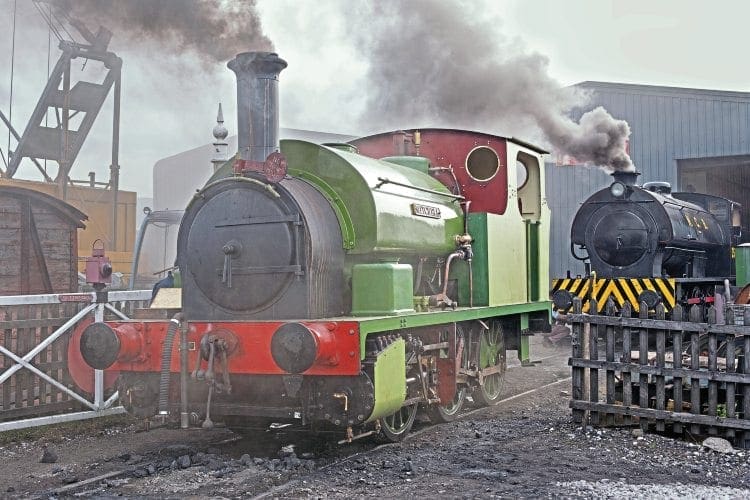
Words: Mark Smithers
In 1965, the Skipton to Ilkley line was closed by Dr Beeching. The line reopened 16 years later as the Embsay & Bolton Abbey Steam Railway and has gone from strength to strength. It is now bidding to reach Skipton.
In less than four decades of operation during the preservation era, the Embsay & Bolton Abbey Steam Railway has made a great deal of progress from its humble beginnings.
The current line originally formed part of the Midland Railway’s route from Skipton to Ilkley, opening in 1888 and then closed by British Railways in 1965. Tentative action towards a revival of at least part of the route took place during the 1970s, and out of these efforts came the formation of the Yorkshire Dales Railway Trust, the present railway’s owning organisation.
This was followed by the acquisition of a Light Railway Order in 1979 and the restoration of Embsay station, which reopened in 1981, along with provision of loco run-around facilities at a point to the west of the station close to the site of Embsay Junction.
Here, a connection was made (then still in place) with the Skipton to Grassington line. This latter route, closed to all passenger traffic in 1969, remains in place to serve Swinden limestone quarry, between Rylstone and Grassington.
The existence of the junction allowed the volunteers to operate a special DMU service between Skipton and Embsay in 1982, but the connection was lifted shortly afterwards.
By 1987, the line had been reinstated between Embsay and Holywell Halt, while Bolton Abbey station building – which had suffered a fair deal from a period of dereliction – was restored to re-create its MR appearance, at least as far as platform one and associated buildings were concerned, in time for reopening in 1998.
This station also features a Midland signalbox salvaged from Guiseley, with the current running line being slightly more than four miles.
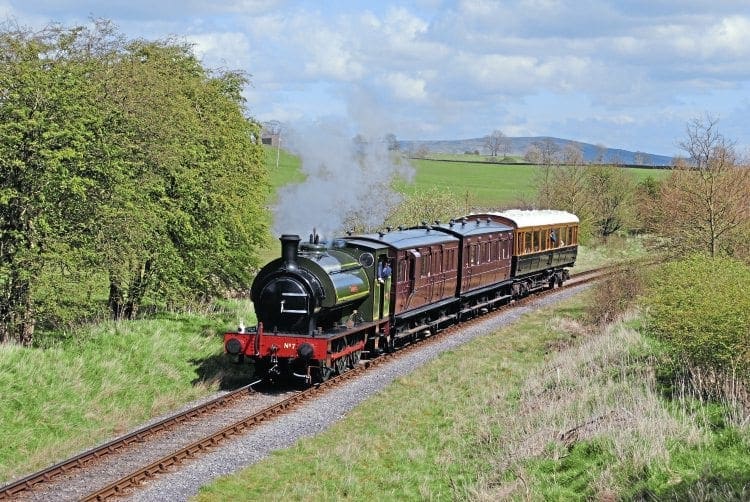
Sympathetically restored
The original platform one station buildings at Embsay have been sympathetically restored externally, but nowadays the ‘main block’ performs the functions of bookshop, gift shop, buffet and toilets, while the weighbridge building has also been restored.
New ticket office and waiting room facilities have been erected on platform one. These were obtained from external sources, namely Barmouth station and Ilkley station, respectively, the latter having begun life as a cabman’s shelter.
Unlike Bolton Abbey station, the footbridge linking the platforms survived, restored during the preservation era, while on platform two (next to the run-around facility) the original waiting room now contains a photographic and artefact display relating to the line’s pre-preservation days.
The signalbox, sheds, workshops and coal dock, none of which are normally open for public access, are situated to the Bolton Abbey side of Embsay’s main station area.
Construction of a 130ft extension to the two-road carriage shed was recently completed, mainly to provide additional protection from the elements for the BR Mk1 carriages that form the backbone of the line’s passenger operations.
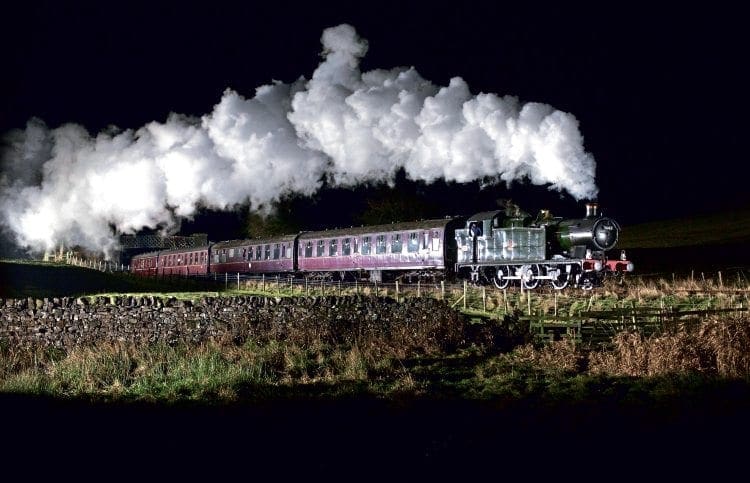
Holywell Halt is a request stop only and is equipped with a waiting shelter and easily accessible picnic areas on both sides of the single running line. Craven Fault, a site of Special Scientific Interest, is also visible in this area.
Between Holywell Halt and Bolton Abbey is Stoneacre loop with its associated signalbox, opened in 1991, where it is possible for two trains to pass each other.
At Bolton Abbey it is intended to reinstate the footbridge and platform two, with its associated buildings, and the Platform 2 Appeal, one of the three major appeals currently in progress in relation to the railway, has been launched in order to achieve this objective. Some work on the structure of the platform has already been undertaken.

Yorkshire connection
The railway’s resident collection of steam locomotives is dominated by industrial practice, with many of the units having had a connection, either built or worked, in the Yorkshire area.
Currently operational are ex-Ackton Hall Colliery (Pontefract) Hunslet inside-cylinder 0-6-0ST Beatrice (2705/1945), and Robert Stephenson & Hawthorns ‘Austerity’ 0-6-0ST No. 35 (7086/1943). These are supplemented by GWR Collett ‘56XX’ class 0-6-2T No. 5643, owned by the Furness Railway Trust and nominally based at the Ribble Steam Railway.
Among the steam locomotives currently under restoration is a sister loco to Beatrice, Primrose No. 2, a 1976 arrival at Embsay from Peckfield Colliery, Micklefield (Hunslet 3175/1952). It has received a new firebox off-site, but still requires much attention to its chassis before it can run under its own steam for the first time since 1999.
Another locomotive that saw much use on the railway during the latter part of the 20th century was Peckett ‘R1’ 0-4-0ST Annie (1159/1908) from Yates, Duxbury Ltd, near Bury, which was taken out of service in 2003, having received a brick arch for the firebox and a new Lempor blastpipe during its initial restoration.
Currently, most of the engine is in the two-road workshop at Embsay, with work having been undertaken on the chassis and boiler (including the manufacture of a new front tubeplate), but the latter component has yet to be re-fitted to the chassis.
Also in a similar state is former East Hetton Colliery Andrew Barclay 0-4-0ST No. 22 (2230/1952), which has received extensive boiler repairs, including a new firebox, together
with work on the motion (much of which was off-site) and a new bunker and saddle tank.

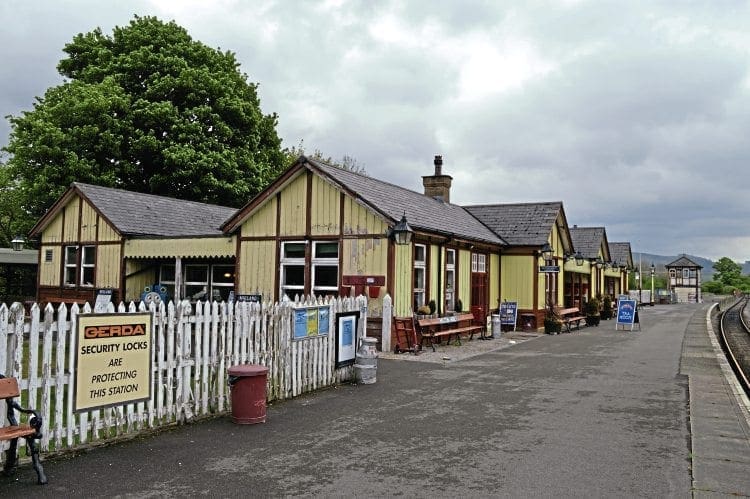
Another important Yorkshire representative among the locomotives under restoration is Hunslet ‘50550’ class 0-6-0ST No. 2414 of 1942.
This locomotive – another Ackton Hall Colliery survivor – was a precursor to the popular ‘Austerity’ design, from which it can be distinguished by such details as a sloping coal bunker, a more defined roof/cabside boundary, split cotter coupling rod bearings, squared-off mainframes, compensated suspension (a feature of many Leeds-built industrial locomotives), and smaller wheels.
This ‘50550’ was never named during its colliery career, but was initially known as Spitfire following arrival at Embsay. It is intended to carry the name Revenge once restoration is complete.
To this end, the frames, (which have had to be restored owing to having been cut back during colliery service), horns, axleboxes, cylinders and motion have been overhauled, and new bufferbeams made, together with some work on the boiler (which will require a new firebox), but as yet no date for a return to steaming condition has been scheduled.
The most recent complete restoration to working order in the locomotive department is outside-cylinder Hudswell, Clarke 0-6-0ST No. 1208, originally delivered to the Ministry of Munitions at Gretna Green on June 19, 1916 as Mitchell.
In common with many domestically based industrial locomotives built or requisitioned for the war effort, it became surplus to Government requirements once peace had resumed, and in 1922 Mitchell found itself in the ownership of Bradford Corporation, being used for both passenger and goods traffic on the Nidd Valley Light Railway, between Pateley Bridge, Lofthouse-in-Nidderdale and Scar House reservoir.
In 1930, the locomotive was re-named Illingworth after a member of the Corporation’s Waterworks Committee.
Following the lifting of light railway in 1936, Illingworth was included in the sell-off of assets at Pateley Bridge on March 1, 1937, and became one of the many Hudswell, Clarke locomotives to be owned by Sir Robert McAlpine, who employed the engine on construction work at Ebbw Vale steelworks under the name Harold.
In 1940 another sale followed, this time to Mowlem’s, with further wartime contract work being undertaken at Swynnerton and Ruddington, the loco being named Swynnerton.
By 1946 the loco was engaged on the Workington breakwater project, and its final duties with Mowlem’s were in connection with construction work at Braehead power station prior to sale for scrap in 1957.
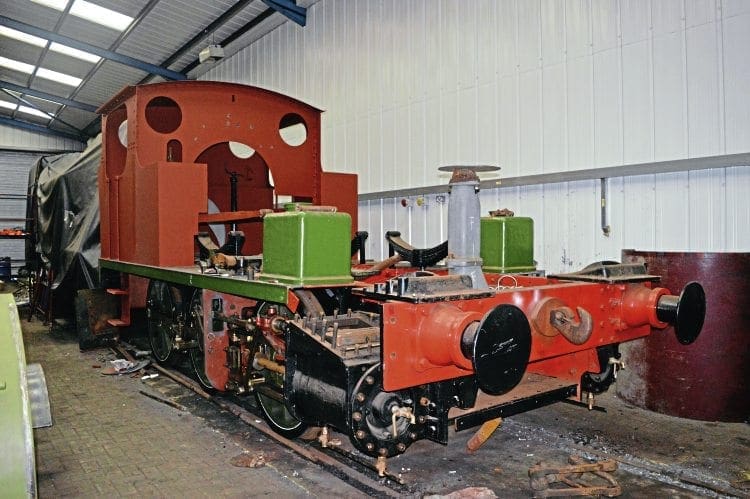
Last surviving
Given the many fine historic industrial locomotives that fell to the breaker’s torch during the 1950s, ’60s and even the ’70s, the survival of this Hudswell, Clarke specimen was little short of miraculous, and it is thought the use of a steel firebox and tubes (a more common practice than normal at the time of the locomotive’s construction during the First World War, given the demand for non-ferrous metals for the manufacture of such items as shell cases) rendered it less of an immediate ‘asset realisation’ priority for the scrap man.
Even so, Hudswell, Clarke No. 1208 spent the next 40 years in private ownership and open storage, gradually deteriorating as a result.
Stephen Middleton, owner of the Stately Trains operations on the Embsay Railway, tracked down the locomotive – now the last surviving ex-Nidd Valley Light Railway engine – to Great Fransham, near Swaffham, Norfolk, negotiated its purchase, and in August 1997 moved it to Ian Riley’s workshops at Bury.
It was clear at an early stage restoration was going to be an extensive undertaking, and the first task performed was the removal of the life-expired tyres and the turning of the wheel centres prior to the fitting of replacements.


During a period of nearly 20 years, restoration has proceeded slowly with much of the work being undertaken off-site.
Work on the chassis has included the refurbishment of the buffers; the replacement of overhaul of all of the brasses, pins and bushes during restoration of the coupling and connecting rods and valve motion; and the boring-out of the cylinders and re-machining of the valve faces, along with the fitting of new bronze valves and piston rings to fit the bores.
The running boards have also been replaced as the original items were extensively corroded, while the necessary repainting of the frames has also been undertaken.
Above running board level, the boiler was overhauled at the premises of Israel Newton Ltd. Close examination showed the internal boiler stays were secured to the firebox by pins rather than being bolted. This meant the entire firebox assembly required removal.
It was eventually found the inner firebox was not fit for further use and was replaced, along with the vertical portions of the outer wrapper and the leading tubeplate. Once this work had been carried out, and prior to re-tubing of the boiler, it was returned to Embsay for the fitting of the replacement saddle tank.
This, along with a new cab, had been enforced by the level of corrosion of the originals.
Likewise, renewal of the smokebox and boiler cladding were also necessary as these items were also life-expired. Once all of the locomotive’s components had been transferred to Embsay, it was possible for the engine to be re-assembled for initial testing and steaming to take place and, after an interval of 60 years, the restored Hudswell moved under its own steam for the first time in preservation on May 2, 2017.
It has been decided to restore the locomotive under a dual identity, carrying the original name Mitchell on the right side of the saddle tank and Illingworth on the left side. The purpose of this measure is to commemorate both guises in which the locomotive saw service on the Nidd Valley Light Railway.
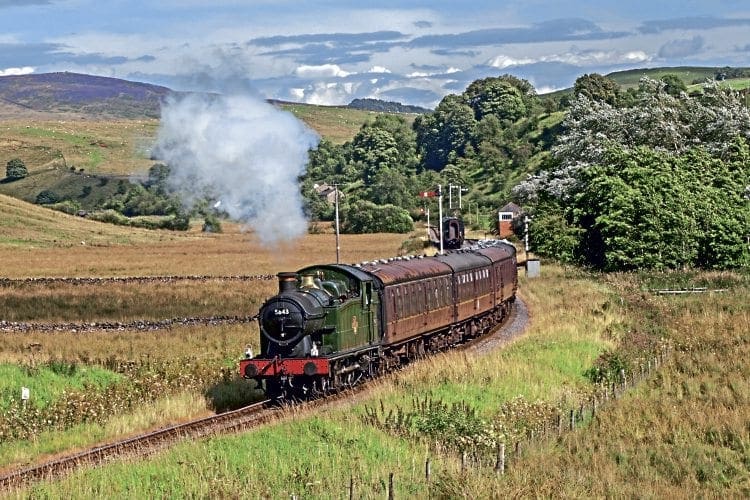
‘Mainstream evolution’
When compared with other surviving outside cylinder Hudswell, Clarke 0-6-0STs, the immediately apparent difference between Mitchell/Illingworth and what may be termed the mainstream line of evolution is the former has outside Walschaerts’ valve gear as opposed to inside Stephenson link motion.
The mainstream counterpart design of No. 1208 is represented in preservation by Walton Park ‘lookalike’ No. 1604 of 1928, currently undergoing restoration on the Mid-Suffolk Light Railway at Brockford.
While both designs have the same cylinder dimensions and similar wheelbase structures, the Mitchell/Illingworth design has the dual advantages of easier accessibility of the valve motion and the superior riding characteristics produced by horizontal as opposed to inclined cylinders (a consequence of not having to incorporate internal valve rods positioned to clear the leading axle).
Nonetheless, No. 1208’s specification was not widely duplicated, although there were two sister engines at Gretna Green, works numbers 1196 and 1197 (delivered respectively on May 4 and June 6, 1916), the latter of which became Watson on the Nidd Valley Light Railway, and ended its operating days at North Gawber Colliery.
The basic chassis layout exemplified by all three locos found favour on Hudswell, Clarke metre- and 3ft 6in-gauge locomotives, and in the one instance was ‘stretched’ to produce an eight-coupled saddle tank locomotive (1644/1930) that was still extant in 2009.
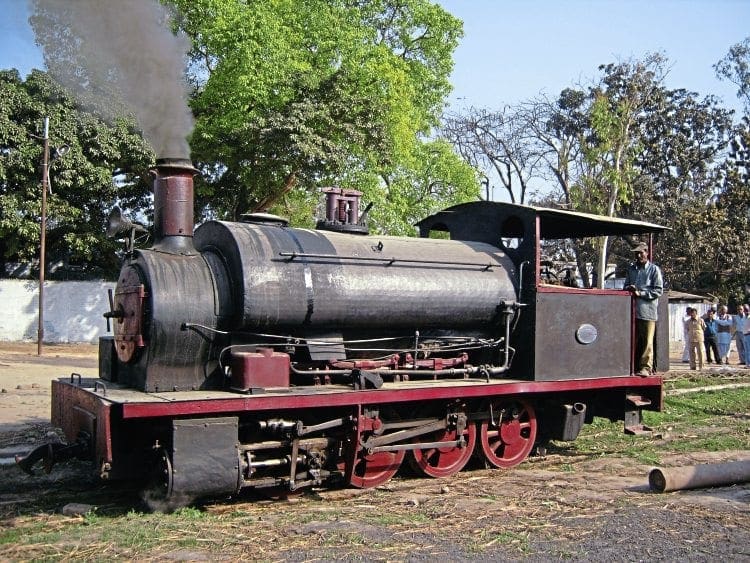
Other steam locomotives currently await their turn in the queue for restoration and one of these is the subject of another of the railway’s fundraising appeals. Hunslet ‘Austerity’ Wheldale (3168/1944) arrived on the railway from Wheldale Colliery, Castleford, shortly after the reopening of Embsay station, returning to service for a 10-year period following re-tubing.
Currently, Wheldale is on static display at Bolton Abbey station and needs a £100,000 overhaul in order to steam again, more than £42,000 of which had been raised by the beginning of May 2017.
Keeping Wheldale company is Sentinel 4wVBT (7232/1927) Ann, while other stored steam locomotives include further examples of the ‘Austerity’ design: a unique surviving Yorkshire Engine Co 0-4-0ST York No. 1, ex-South Kirby Colliery, near Barnsley (2474/1949), and 1923-vintage inside cylinder Hunslet 0-6-0ST Airedale (1440/1923), transferred from its original workplace to Ackton Hall Colliery in 1963, and having awaited its return to steam since arrival at Embsay on December 22, 1975.
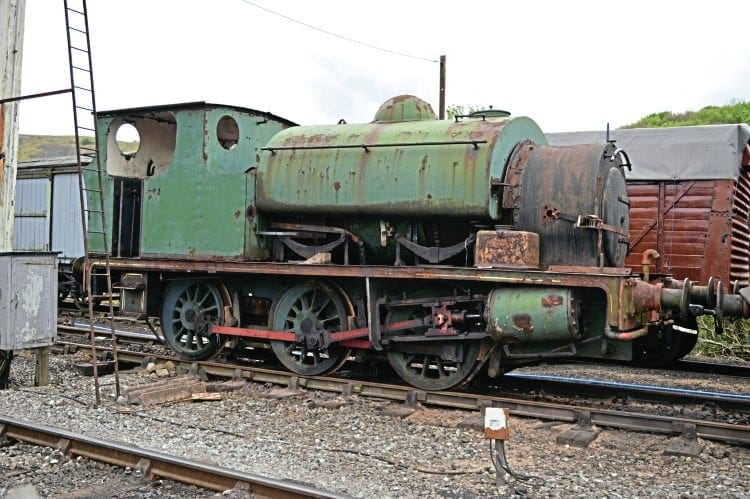
Greatest significance
There are a variety of diesel locos on the railway, both purpose-built for industrial use and former BR-owned examples, including 1952-built Drewry Class 04 0-6-0 204hp diesel-mechanical No. D2203, which was once fitted with side-sheets for working the Wisbech & Upwell Tramway, and Swindon-built Class 14 0-6-0 diesel-hydraulic No. D9513, now running as NCB No. 38.
Of all the internal combustion units currently to be found on the railway, however, the item of greatest significance is the former North Eastern Railway ‘Autocar’ No. 3170, currently undergoing the final stages of its restoration at Embsay.
In 1903 this vehicle and its sister No. 3171 were completed at York Carriage Works under the auspices of Vincent Raven, then assistant CME of the North Eastern Railway.
They are believed to have been the world’s first petrol-electric railcars (Raven having been an enthusiast for electric traction in a variety of forms), and each was initially equipped with an 80hp vertical Napier engine, replaced after trials by an 85hp horizontal four-cylinder model, driving two 55hp Westinghouse traction motors on the leading bogie via a generator.
These 52-seat vehicles were originally intended to provide a shuttle service between Hartlepool and West Hartlepool stations, but they were destined to spend much of their service careers based at Selby, for use on the Cawood branch, after their seating capacity had been reduced to 48 to provide a luggage area.
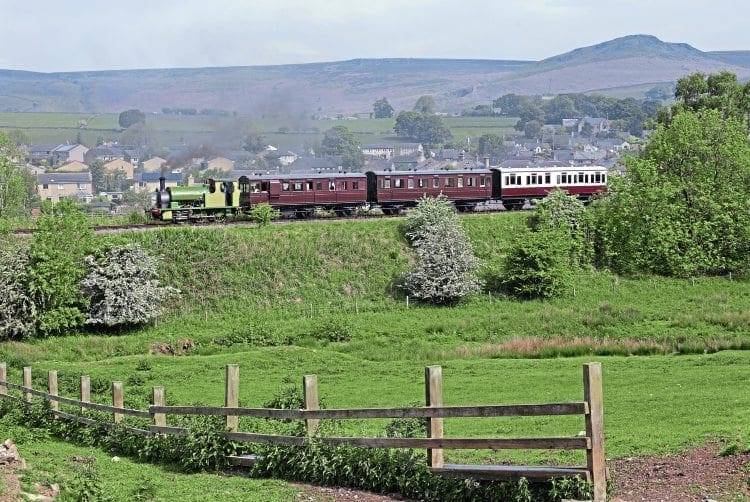
Immediately after the Grouping, No. 3170 received another replacement petrol engine, a 225hp with six cylinders, enabling it to haul a trailer carriage, but it was withdrawn from service on April 4, 1931, having survived its sister by slightly more than 10 months.
Its body was sold and became a holiday home at Kirkbymoorside, near Pickering, where it was cut into two pieces, but otherwise maintained in relatively good condition.
It was rescued by Stephen Middleton in September 2003 and transferred to the railway. A suitable underframe has been sourced, along with a correct-pattern ‘Fox’ pressed steel trailing bogie and a Class 416 EMU bogie for the leading (powered) end.
Running trials
As modern safety requirements do not enable the re-installation of a large petrol engine in the unit, it has been decided to install a Cummins 300hp QSL9 diesel engine (accommodated within a safety cage), allied to modern generator and traction motor equipment and control systems, the latter concealed within traditional tramway-style control columns for both driving positions.
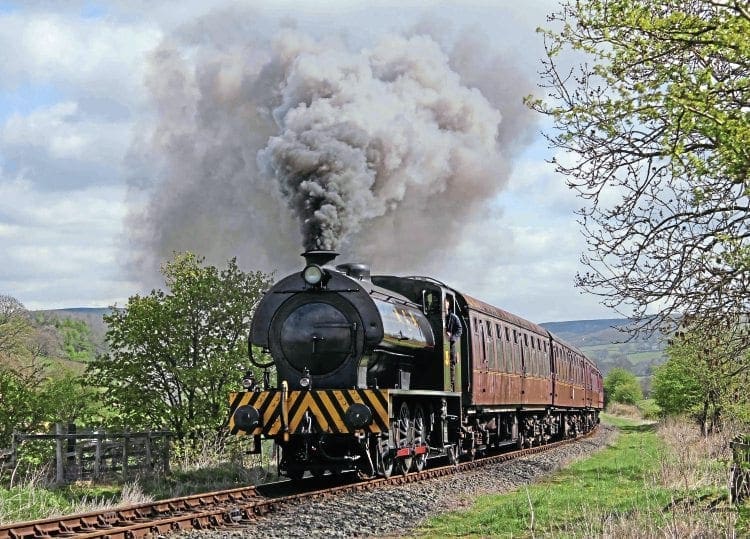
Refurbishment of the trailing bogie was undertaken at the Ffestiniog Railway’s Boston Lodge works, while most of the chassis modification and assembly, including the power unit, took place at Loughborough on the Great Central Railway, where running trials took place on March 17, 2016.
On July 22 last year, the two pieces of the body were lifted onto the chassis, which had been transferred to Embsay’s Priors Lane Permanent Way Department.
Since then, work has been proceeding on the vehicle, including repainting and the fitting of dual-braking equipment to permit working with other vacuum-braked stock.
In order to increase seating capacity, and in line with post-1923 practice, 58-seat former NER bogie ‘auto trailer’ car No. 3453, built in 1904, has been acquired from the NER Carriage Association, the vehicle having been in store at Levisham on the North Yorkshire Moors Railway. This is now undergoing restoration at Embsay for use with No. 3170.
At the time of writing, the outstanding work on the combined unit includes the fitting of two control desks, the roof and finishing the leading end of the body, while a dual-braking system requires fitting to the trailer car.

It is currently hoped all of this work can be completed by November 2017 in time for the combination to make its public debut in 2018. From the point of view of extending the current running line, the Ilkley direction would not appear to offer a great deal of potential in the foreseeable future as Addingham station has been demolished and redevelopment work in the vicinity of Ilkley station effectively rules out re-connection with the main line connection at that end.
The re-instatement of Embsay Junction, to provide a connection to Skipton station is, however, a useful possibility, especially given the potentially precarious future of the bus services that currently connects with the railway.
Network Rail has commissioned a feasibility study into the cost of re-instating the junction together with the restoration of platforms 5 and 6 at Skipton, estimated at £2.6million.
JMP Consulting has been working on a business plan for the project, which also constitutes one of the railway’s fundraising appeals.
It can only be hoped this project will come to fruition in the not-too-distant future and provide a new connection to one of Yorkshire’s premier tourist attractions.


